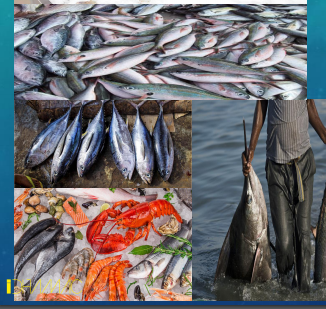
As the agro-pastoral system and livestock sector has remained the economic backbone of Somaliland, historically, the fisheries sector has not been of precedence for the people of Somaliland. Successive years of prolonged periods of abnormally low rainfall culminated in a year of severe drought during 1974 to 1976 which resulted in an overall government policy that resettled many drought-affected people along the coast. As a result of their resettlement, people were encouraged to take up fishing. This was followed by the construction of Berbera Cold Storage and the Fishing Centers in Zeila and Berbera. Consequently, an increased trend was observed in fish consumption in the period 1986-1989, even though the Somaliland people remain some of the lowest consumers of fish and fish products.
Thought an estimated 3000 tons of fish are caught locally per year, an estimated potential catch 190,000-210,000 tons of fish, 60 times the current levels of harvesting is unexploited.
Climate and Weather
It is arid and hot most of the time, while precipitation is less than 50mm annually. Water Temperature is 21C in January & 37C in October. Two monsoon winds are experienced annually. South West monsoon blows June to September, while North –east blows October to March.
There are major settlements of fishing communities along the coast of Somaliland. Starting from west, they are: Loyado, Tokoshi, Zeila, lughaya, Elsheik, Bulahar, Geri, Berbera, Elgerdi, Karin, Shal’o, His, Mait, Laskorey, Elayo.
Coast Characteristics
The western coast has sandy wide beaches, while the eastern coast has relatively narrow sandy beaches broken at intervals by rocky outcrops and cliffs.
The continental shelf in the eastern coast is between 5 to 10Km wide when measured at the 200m depth line. The shelf becomes wider reaching around 30- 50Km near Zeila town area at the border with Djibouti.
Table 6 illustrates the category of Fresh Fish, Sea Cucumber, Shark Fin and Lobster market share per type of exports. The price of marine product per type is mentioned in the table across the regions of Somaliland. The quantity of marine product exported during the annual of 2019 is multiplied by the current local price, which gives the total value of export.
Coastal and Marine Exportation Jan-Dec 2019
|
Table 6: Fish Market Share per type of export |
|||||
|
Year |
Item Name |
Unite Measure |
Quantity Export |
Unit price value |
Total Value |
|
2019 |
Fresh fish |
KGs |
596,968 |
$0.25 |
$149,242 |
|
2019 |
Sea Cucumber |
KGs |
2,897 |
$5.o |
$14,485 |
|
2019 |
Shark Fin |
KGs |
8,123 |
$15.0 |
$121,845 |
|
2019 |
Lobster |
KGs |
3,800 |
$15.0 |
$57,000 |
Source: MoFD/Customs Department
The principal commercial fish normally landed by the artisan fishery sector comprise of many demersal and pelagic species. The most important groups include the following families:
- SERRANIDAE: Groupers, Sea basses, Rock cod, Hinds, Combers, Coral trout, Iyretails and Soap fish.
- CARANGIDAE: Jacks, Trevallies, Scads, Queen fish, Runners and Pompos.
- LUTJANIDAE: Snappers, Job fish.
- HAEMULLIDAE: Grunts, Sweet lips, Rubber lips and Hot lips.
- LETHRINIDAE: Emperors, Breams, Pig face, and Large eye breams.
- MULLIDAE: Goat fish.
- SCOMBRIDAE: Albacores, Bonitos, Kawa kawa, Mackerels, Tuna and Waho.
The coral reef on the coast of Somaliland is also a habitat for other non-traditional marine resources, such as mollascas and crustaceans. Though, the commercial viability of these resources is not known, giant clams, abalones and mussels have been found.
Artisan fishermen around Berbera and Karin supply local urban markets in Burao, Hargeisa and Berbera through several small fishing companies, which sell up to 90 metric tons per month in these markets.
The Las Qorey Tuna Canning factory in the east is the only fish processing plant in the country. It constitutes the largest available market for artisan fishermen in that area. Since the plant started its operations in 2001, more than half of the boats and fishermen in Somaliland work for it. During the nine months that small boats can safely go out to sea, the plant operates at full capacity and processes up to 16 tons of fresh tuna per day, averaging an estimated 4320 tons per year.
Fish stocks off the coast of Somaliland present an immense opportunity for motivated investors. Somaliland fishermen are currently capturing only 1% of the estimated sustainable catch in their waters. Demand for fish is rising in Somaliland, and neighbouring countries are eager to import more fish. Clearly, there are financial incentives to bolster the efforts to increase the annual catch. To do so will require determined investors that seek to not only profit from their investment, but also desire to positively impact the lives of those living in Somaliland. Investments into the fishing industry will introduce numerous jobs opportunities drawing on a wide array of skill sets. This will prove to be an effective method to provide prospects for the high number of unemployed individuals seeking stable work. Profit margins already exist in the current state of the industry and investment into infrastructure and processes will widen those margins while also assisting in the development of Somaliland as a whole.
To attract investment into Somaliland, the government offers significant tax incentives. The first three years of operation in Somaliland are offered at a 0% tax rate for foreign investors and diaspora. Following that period, investors are eligible for a 50% reduction on taxable profits making it a lasting attractive option. In addition, all materials and equipment brought to Somaliland for the purpose of business development are also exempt from import taxes. After developing the local market in Somaliland, other markets will open. With a rising level of standards and professionalism, markets in Ethiopia, Djibouti, and Saudi Arabia among others, which have all expressed interest, will be more receptive to importing Somaliland fish.
.png)


